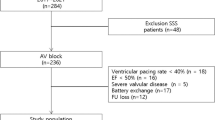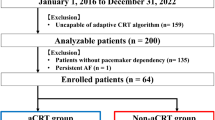Abstract
Purpose
The aim of our study was to assess the prevalence of pacemaker-induced cardiomyopathy (PMiCMP) and its response to biventricular stimulation and optimal medical therapy.
Methods
To identify patients with PMiCMP, we screened all patients that presented for pacemaker interrogation in our outpatient clinic in 2012 and 2013 (n = 615). Left ventricular (LV) function was assessed by transthoracic echocardiography. PMiCMP was defined as deterioration of left ventricular ejection fraction (LVEF) <45 % unexplained by other cardiac disease under a right ventricular (RV) pacing percentage ≥90 %. If symptoms and LV dysfunction persisted under heart failure medication, patients were offered to receive an upgrade to biventricular stimulation (cardiac resynchronization therapy, CRT). CRT response was defined as a decrease of the LV end-systolic volume (LVESV) of ≥15 %.
Results
Thirty-seven patients were found to have a PMiCMP. The prevalence of PMiCMP in our total cohort was 6.0 %. In 20 PMiCMP patients, an upgrade to a CRT device was performed after a minimum of 3 months of optimal medical therapy. The remaining PMiCMP patients either refused an upgrade or were in good functional status. The LVEF before CRT upgrade was 33.3 ± 5.2 % and improved to 47.6 ± 9.3 % (P < 0.001) within 6 months. Positive response to CRT was observed in 17 patients (85 %). In the group without device upgrade, LVEF was 40.5 ± 5 % and did not change during the follow-up period of 1 year.
Conclusions
Optimal medical therapy lacks efficacy in PMiCMP patients. The response rate to CRT was significantly higher in PMiCMP patients compared to average CRT patients.




Similar content being viewed by others
References
Delgado, V., Tops, L. F., Trines, S. A., Zeppenfeld, K., Marsan, N. A., Bertini, M., Holman, E. R., Schalij, M. J., & Bax, J. J. (2009). Acute effects of right ventricular apical pacing on left ventricular synchrony and mechanics. Circulation. Arrhythmia and Electrophysiology, 2(2), 135–145.
Nahlawi, M., Waligora, M., Spies, S. M., Bonow, R. O., Kadish, A. H., & Goldberger, J. J. (2004). Left ventricular function during and after right ventricular pacing. Journal of the American College of Cardiology, 44(9), 1883–1888.
Nielsen, J. C., Andersen, H. R., Thomsen, P. E., Thuesen, L., Mortensen, P. T., Vesterlund, T., & Pedersen, A. K. (1998). Heart failure and echocardiographic changes during long-term follow-up of patients with sick sinus syndrome randomized to single-chamber atrial or ventricular pacing. Circulation, 97(10), 987–995.
Sweeney, M. O., Hellkamp, A. S., Ellenbogen, K. A., Greenspon, A. J., Freedman, R. A., Lee, K. L., Lamas, G. A., & Investigators, M. O. S. T. (2003). Adverse effect of ventricular pacing on heart failure and atrial fibrillation among patients with normal baseline QRS duration in a clinical trial of pacemaker therapy for sinus node dysfunction. Circulation, 107(23), 2932–2937.
Chan, J. Y., Fang, F., Zhang, Q., Fung, J. W., Razali, O., Azlan, H., Lam, K. H., Chan, H. C., & Yu, C. M. (2011). Biventricular pacing is superior to right ventricular pacing in bradycardia patients with preserved systolic function: 2-year results of the PACE trial. European Heart Journal, 32(20), 2533–2540.
Funck, R. C., Blanc, J. J., Mueller, H. H., Schade-Brittinger, C., Bailleul, C., Maisch, B., & BioPace Study G. (2006). Biventricular stimulation to prevent cardiac desynchronization: rationale, design, and endpoints of the ‘Biventricular Pacing for Atrioventricular Block to Prevent Cardiac Desynchronization (BioPace)’ study. Europace : European Pacing, Arrhythmias, and Cardiac Electrophysiology : Journal of the Working Groups on Cardiac Pacing, Arrhythmias, and Cardiac Cellular Electrophysiology of the European Society of Cardiology, 8(8), 629–635.
Kanzaki, H., Bazaz, R., Schwartzman, D., Dohi, K., Sade, L. E., & Gorcsan, J., 3rd. (2004). A mechanism for immediate reduction in mitral regurgitation after cardiac resynchronization therapy: insights from mechanical activation strain mapping. Journal of the American College of Cardiology, 44(8), 1619–1625.
European Society of C, European Heart Rhythm A, Brignole, M., Auricchio, A., Baron-Esquivias, G., Bordachar, P., Boriani, G., Breithardt, O. A., Cleland, J., Deharo, J. C., Delgado, V., Elliott, P. M., Gorenek, B., Israel, C. W., Leclercq, C., Linde, C., Mont, L., Padeletti, L., Sutton, R., & Vardas, P. E. (2013). 2013 ESC guidelines on cardiac pacing and cardiac resynchronization therapy: the task force on cardiac pacing and resynchronization therapy of the European Society of Cardiology (ESC). Developed in collaboration with the European Heart Rhythm Association (EHRA). Europace : European Pacing, Arrhythmias, and Cardiac Electrophysiology : Journal of the Working Groups on Cardiac Pacing, Arrhythmias, and Cardiac Cellular Electrophysiology of the European Society of Cardiology, 15(8), 1070–1118.
Epstein, A. E., DiMarco, J. P., Ellenbogen, K. A., Estes, N. A., 3rd, Freedman, R. A., Gettes, L. S., Gillinov, A. M., Gregoratos, G., Hammill, S. C., Hayes, D. L., Hlatky, M. A., Newby, L. K., Page, R. L., Schoenfeld, M. H., Silka, M. J., Stevenson, L. W., Sweeney, M. O., Tracy, C. M., Darbar, D., Dunbar, S. B., Ferguson, T. B., Jr., Karasik, P. E., Link, M. S., Marine, J. E., Shanker, A. J., Stevenson, L. W., Stevenson, W. G., Varosy, P. D., American College of Cardiology F, & American Heart Association Task Force on Practice G, Heart Rhythm S. (2013). 2012 ACCF/AHA/HRS focused update incorporated into the ACCF/AHA/HRS 2008 guidelines for device-based therapy of cardiac rhythm abnormalities: a report of the American College of Cardiology Foundation/American Heart Association Task Force on Practice Guidelines and the Heart Rhythm Society. Journal of the American College of Cardiology, 61(3), e6–75.
Zhang, X. H., Chen, H., Siu, C. W., Yiu, K. H., Chan, W. S., Lee, K. L., Chan, H. W., Lee, S. W., Fu, G. S., Lau, C. P., & Tse, H. F. (2008). New-onset heart failure after permanent right ventricular apical pacing in patients with acquired high-grade atrioventricular block and normal left ventricular function. Journal of Cardiovascular Electrophysiology, 19(2), 136–141.
Dreger, H., Maethner, K., Bondke, H., Baumann, G., & Melzer, C. (2012). Pacing-induced cardiomyopathy in patients with right ventricular stimulation for >15 years. Europace : European Pacing, Arrhythmias, and Cardiac Electrophysiology : Journal of the Working Groups on Cardiac Pacing, Arrhythmias, and Cardiac Cellular Electrophysiology of the European Society of Cardiology, 14(2), 238–242.
Toff, W. D., Camm, A. J., Skehan, J. D., United Kingdom P, & Cardiovascular Events Trial I. (2005). Single-chamber versus dual-chamber pacing for high-grade atrioventricular block. New England Journal of Medicine, 353(2), 145–155.
Leclercq, C., Cazeau, S., Lellouche, D., Fossati, F., Anselme, F., Davy, J. M., Sadoul, N., Klug, D., Mollo, L., & Daubert, J. C. (2007). Upgrading from single chamber right ventricular to biventricular pacing in permanently paced patients with worsening heart failure: the RD-CHF Study. Pacing and Clinical Electrophysiology, 30(Suppl 1), S23–30.
Nazeri, A., Massumi, A., Rasekh, A., Saeed, M., Frank, C., & Razavi, M. (2010). Cardiac resynchronization therapy in patients with right ventricular pacing-induced cardiomyopathy. Pacing and Clinical Electrophysiology, 33(1), 37–40.
Kirkfeldt, R. E., Johansen, J. B., Nohr, E. A., Jorgensen, O. D., & Nielsen, J. C. (2014). Complications after cardiac implantable electronic device implantations: an analysis of a complete, nationwide cohort in Denmark. European Heart Journal, 35(18), 1186–1194.
Yu, C. M., Chan, J. Y., Zhang, Q., Omar, R., Yip, G. W., Hussin, A., Fang, F., Lam, K. H., Chan, H. C., & Fung, J. W. (2009). Biventricular pacing in patients with bradycardia and normal ejection fraction. New England Journal of Medicine, 361(22), 2123–2134.
van Geldorp, I. E., Vernooy, K., Delhaas, T., Prins, M. H., Crijns, H. J., Prinzen, F. W., & Dijkman, B. (2010). Beneficial effects of biventricular pacing in chronically right ventricular paced patients with mild cardiomyopathy. Europace : European Pacing, Arrhythmias, and Cardiac Electrophysiology : Journal of the Working Groups on Cardiac Pacing, Arrhythmias, and Cardiac Cellular Electrophysiology of the European Society of Cardiology, 12(2), 223–229.
Khurshid, S., Epstein, A. E., Verdino, R. J., Lin, D., Goldberg, L. R., Marchlinski, F. E., & Frankel, D. S. (2014). Incidence and predictors of right ventricular pacing-induced cardiomyopathy. Heart Rhythm.
Park, H. E., Kim, J. H., Kim, H. K., Lee, S. P., Choi, E. K., Kim, Y. J., Oh, S., Cho, G. Y., & Sohn, D. W. (2012). Ventricular dyssynchrony of idiopathic versus pacing-induced left bundle branch block and its prognostic effect in patients with preserved left ventricular systolic function. The American Journal of Cardiology, 109(4), 556–562.
Kang, S. J., Song, J. K., Yang, H. S., Song, J. M., Kang, D. H., Rhee, K. S., Nam, G. B., Choi, K. J., Kim, J. J., & Kim, Y. H. (2004). Systolic and diastolic regional myocardial motion of pacing-induced versus idiopathic left bundle branch block with and without left ventricular dysfunction. The American Journal of Cardiology, 93(10), 1243–1246.
Sweeney, M. O., & Hellkamp, A. S. (2006). Heart failure during cardiac pacing. Circulation, 113(17), 2082–2088.
Cano, O., Osca, J., Sancho-Tello, M. J., Sanchez, J. M., Ortiz, V., Castro, J. E., Salvador, A., & Olague, J. (2010). Comparison of effectiveness of right ventricular septal pacing versus right ventricular apical pacing. The American Journal of Cardiology, 105(10), 1426–1432.
Zanon, F., Bacchiega, E., Rampin, L., Aggio, S., Baracca, E., Pastore, G., Marotta, T., Corbucci, G., Roncon, L., Rubello, D., & Prinzen, F. W. (2008). Direct his bundle pacing preserves coronary perfusion compared with right ventricular apical pacing: a prospective, cross-over mid-term study. Europace : European Pacing, Arrhythmias, and Cardiac Electrophysiology : Journal of the Working Groups on Cardiac Pacing, Arrhythmias, and Cardiac Cellular Electrophysiology of the European Society of Cardiology, 10(5), 580–587.
Deshmukh, P., Casavant, D. A., Romanyshyn, M., & Anderson, K. (2000). Permanent, direct His-bundle pacing: a novel approach to cardiac pacing in patients with normal His-Purkinje activation. Circulation, 101(8), 869–877.
Flather, M. D., Yusuf, S., Kober, L., Pfeffer, M., Hall, A., Murray, G., Torp-Pedersen, C., Ball, S., Pogue, J., Moye, L., & Braunwald, E. (2000). Long-term ACE-inhibitor therapy in patients with heart failure or left-ventricular dysfunction: a systematic overview of data from individual patients. ACE-Inhibitor Myocardial Infarction Collaborative Group. Lancet, 355(9215), 1575–1581.
The SOLVD Investigators. (1992). Effect of enalapril on mortality and the development of heart failure in asymptomatic patients with reduced left ventricular ejection fractions. New England Journal of Medicine, 327(10), 685–691.
The MERIT-HF Study Group. (1999). Effect of metoprolol CR/XL in chronic heart failure: Metoprolol CR/XL Randomised Intervention Trial in Congestive Heart Failure (MERIT-HF). Lancet, 353(9169), 2001–2007.
Pitt, B., Zannad, F., Remme, W. J., Cody, R., Castaigne, A., Perez, A., Palensky, J., & Wittes, J. (1999). The effect of spironolactone on morbidity and mortality in patients with severe heart failure. Randomized Aldactone Evaluation Study Investigators. New England Journal of Medicine, 341(10), 709–717.
Author information
Authors and Affiliations
Corresponding author
Ethics declarations
Ethics approval and consent to participate
The study conforms to the Declaration of Helsinki. The study is approved by the ethics committee of the Charite Universitätsmedizin Berlin. All patients provided written informed consent.
Additional information
Marius Schwerg and Henryk Dreger contributed equally to this work.
Rights and permissions
About this article
Cite this article
Schwerg, M., Dreger, H., Poller, W.C. et al. Efficacy of optimal medical therapy and cardiac resynchronization therapy upgrade in patients with pacemaker-induced cardiomyopathy. J Interv Card Electrophysiol 44, 289–296 (2015). https://doi.org/10.1007/s10840-015-0059-4
Received:
Accepted:
Published:
Issue Date:
DOI: https://doi.org/10.1007/s10840-015-0059-4




